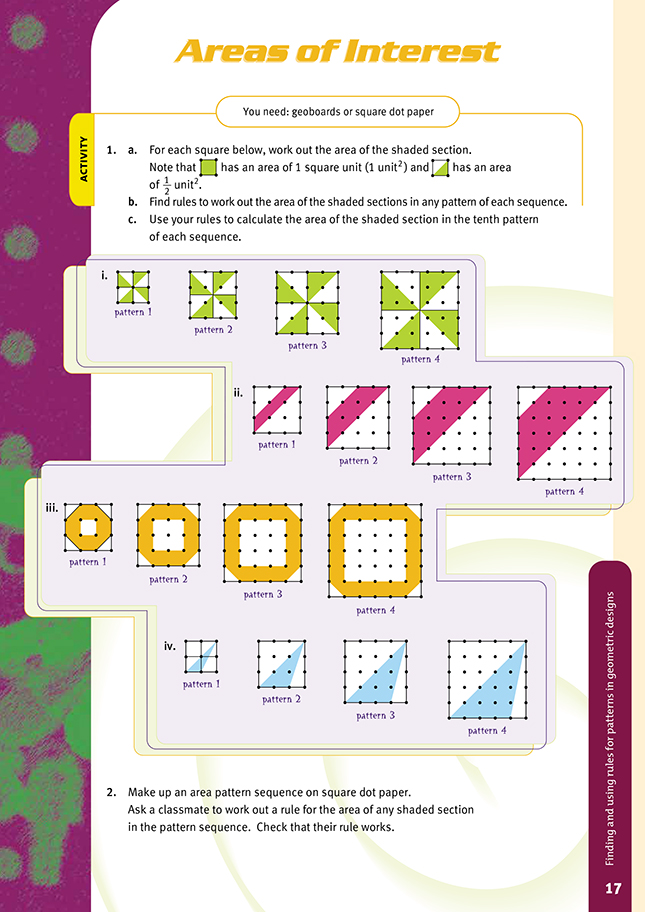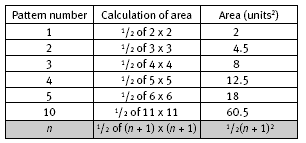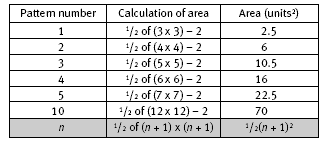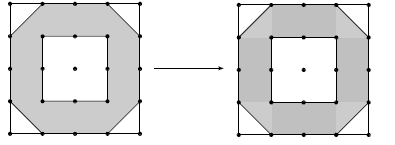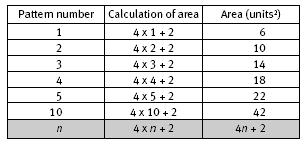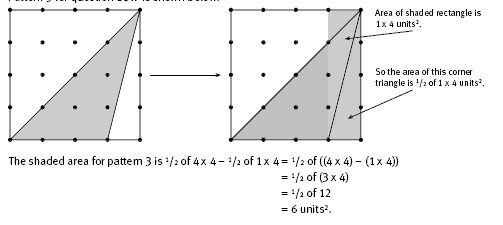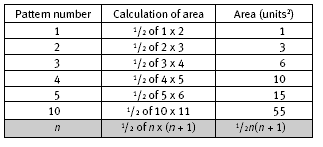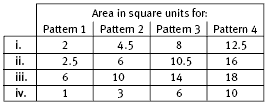This is a level 5 algebra strand activity from the Figure It Out series.
A PDF of the student activity is included.
Click on the image to enlarge it. Click again to close. Download PDF (84 KB)
find a rule to describe a geometric pattern
FIO, Level 4+, Algebra, Book Four, Areas of Interest, page 17
geoboards or square dot paper (see Copymaster)
In this activity, the students must devise ways to calculate the shaded area for each pattern shown. They may attempt to calculate the shaded area directly or they may consider the non-shaded area and then subtract this from the total area shown. In order to find a rule for any pattern in a particular sequence, the students will find it helpful to record the areas in a table. The comments below on each section of question 1c will help the students with the areas and rules in questions 1a and 1b.
In question 1c i, the shaded area for each pattern is half the total area enclosed in the pattern. For example, the total area enclosed for pattern 2 below is 3 units by 3 units, or 9 units2. The shaded area is half of the
total area enclosed, that is, 1/2 of 9 units2 = 4.5 units2. Similarly, the shaded area for pattern 3 is 1/2 of 16 units2 = 8 units2.
The following table shows the shaded areas and number patterns for the sequence of shaded areas in question 1c i.
So, for example, the shaded area in the hundredth pattern is 1/2 of 101 x 101 = 5 100.5 units2.
Pattern 2 for question 1c ii is shown below. There are several approaches that might be taken to this question. One approach is to analyse the shaded area in the way shown below.
The shaded area can be thought of as the difference between the highlighted area in the second diagram and the highlighted area in the third diagram. Note that the highlighted area in the third diagram (1/2 of 2 x 2 = 2 units2) is the same for each pattern in question ii.
The shaded area for pattern 2 = 1/2 x (4 x 4) – 2 units2
= 1/2 x 16 – 2
= 6 units2
The associated table is:
Pattern 2 for question 1c iii is shown below.
The shaded area for this pattern can be considered as consisting of 4 lots of 2 units2 (2 on each side) plus the 4 triangles that link these sides. The calculation is then 4 x 2 + 4 x 1/2 = 4 x 2 + 2 units2. The associated table is:
So, for example, the shaded area in the hundredth pattern is 4 x 100 + 2 = 402 units2.
Pattern 3 for question 1c iv is shown below.
The associated table is:
So, for example, the shaded area for the hundredth pattern is 1/2 of 100 x (100 + 1) = 1/2 x 100 x 101
= 5 050 units2
Note that we might also approach question 1c iv in the following way: If n is the pattern number, then the area of the narrow unshaded triangle is
![]()
(For example, in pattern 3, the area of this triangle is (3 +1)/2 = 2). So an alternative formula for calculating the total area shaded would be
1/2(n + 1)2 – 1/2(n + 1) = 1/2((n + 1)2 – (n + 1)). It can be shown that this
equation is equivalent to 1/2n(n + 1):
1/2(n + 1)2 – 1/2(n + 1)
= 1/2((n + 1)2 – (n + 1))
= 1/2(n2 + 2n + 1 – n – 1)
= 1/2(n2 + n)
= 1/2n(n + 1)
Answers to Activity
1a.
b. Answers may vary. Possible rules include:
i. The shaded section is half the area of the surrounding square.
ii. The area of the shaded section is half the area of the surrounding square minus the
area of the left-hand corner triangle, which is always 2 units2.
iii. The area of the shaded section is the area of the surrounding square minus the area of the centre square (the square of the pattern number) minus the area of the 4 corner
triangles or half-squares (which is always 2 units2). The area of the shaded square can also be viewed as 4 times the pattern number plus 2 (the 4 half-squares).
iv. The area of the shaded section is half the area of the surrounding square minus the
area of the narrow (unshaded) triangle. The area of this narrow triangle is
c. i. 60.5 units2. The tenth pattern is an 11 by 11 square with an area of 121 units2. Half of this area is 60.5 units2.
ii. 70 units2. The tenth pattern is a 12 by 12 square with an area of 144 units2. So the
area of the shaded section is 1/2(144) – 2 = 70 units2.
iii. 42 units2. The tenth pattern is a 12 x 12 square with an area of 144 units2. It will have a shaded section of 4 x 10 + 2 = 42 units2.
iv. 55 units2. The tenth pattern is an 11 x 11 square with an area of 121 units2. The area of the shaded triangle is equal to the area of one half of a 10 by 11 rectangle, that is 1/2 of 10 x 11 = 55 units2.
2. Practical activity
